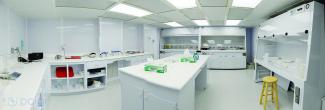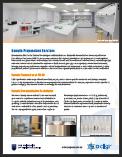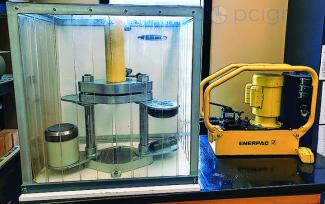We perform a wide range of end-to-end sample preparation techniques for elemental, isotopic, and geochronological analyses. Proper preparation is key to ensuring that the data obtained are representative of the sample.
Sample Crushing and Homogenization Techniques
Ultra-clean Wet Chemistry Techniques
For analyses at low analyte concentrations, all handling of powdered samples takes place inside our certified Class 100 clean-room laboratories.
For trace element analyses and isotopic analyses via ICP-MS or TIMS, we can perform the following chemical techniques:
- Leaching of samples inside Savillex® PFA beakers (only for samples exposed to seawater alteration, for isotopic analyses)
- Acid digestion of sample powders into solution by hotplate “flux” inside Savillex® PFA vials
- Acid digestion of sample powders into solution inside high-pressure Teflon® vessels for samples with refractory minerals
- Ion-exchange chromatography to pre-concentrate analytes of interest prior to analysis
We use only ultra-clean water (Elix/MilliQ water filtration system), and either quartz-distilled or sub-boiled acids (Savillex DST-1000 and DST-4000 systems) during sample preparation.
The entire air-handling system for our Class 100 clean labs is filtered by 42 HEPA filters, with two levels of pre-filtration. Labs are accessed via a vestibule and are restricted to authorized users. Full gowning is required inside the labs.
PCIGR has 3 metal-free clean labs that each have an independent air supply:
- Tracer lab: devoted to Pb-Sr-Nd-Hf separation for isotopic analyses, together with separation for heavy stable isotopic analyses
- U-Pb lab: used only for U-Pb zircon (+baddeleyite/monazite/titanite) chemistry
- Low-level lab: reserved for chemical preparations for analyses that have special requirements of low concentrations (sub-ppm to ppb)

Class 100 clean laboratory with metal-free laminar flow hoods at PCIGR. Photo: D. Weis.
Other Sample Preparation Techniques & Lab Environments
For analyses that do not require ultra-clean settings, all sample weighing and wet chemistry takes place in our regular sample preparation labs prior to analysis.
PCIGR is also equipped with sawing and polishing equipment to prepare samples and sample mounts for in-situ and microanalysis.
We accept pre-prepared samples for analysis and can provide advice about optimal sample preparation if you choose to prepare your own samples. First-time users are advised to contact our scientific and technical team before preparing samples. See contacts below.
Capabilities, Contacts and Costs
The preparation of samples by our technical team is included as part of the geochemical analysis package and is costed separately on our Fees page.
PCIGR can process the following types of sample materials*:
- Rocks and minerals
- Sediments, soils and dusts
- Water (e.g., sea water, lake water, pore water)
- Plant materials
- Animal tissue (both soft tissues and mineralized bones and teeth)
- Foods and pharmaceuticals
- Archaeological materials
- Advanced manufacturing materials
* Please note that PCIGR is not equipped to accept radioactive materials.
First-time users intending to send raw samples to PCIGR for sample preparation and associated analyses should review the relevant analytical services pages on this website.
For questions about sample preparation, contact:
- Vivian Lai for trace elements
- Dr. Dominique Weis and Dave Daquioag for radiogenic isotopes
- Dr. Marg Amini for non-traditional stable isotopes and laser ablation
- Dr. Kendra Chritz for light stable isotopes
- Dr. Corey Wall for U-Pb geochronology
Please do not submit raw or prepared samples without first speaking to us. Thank you.

